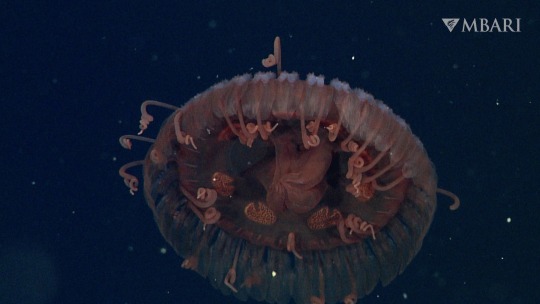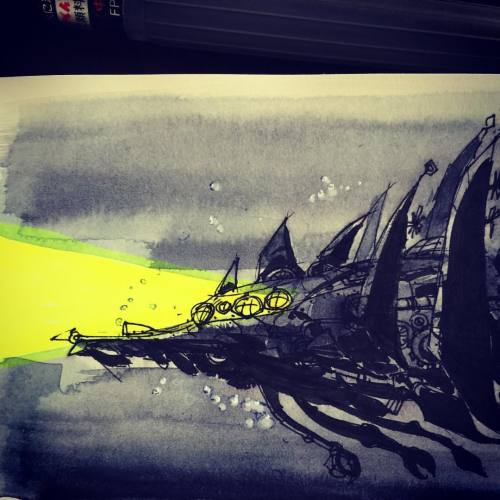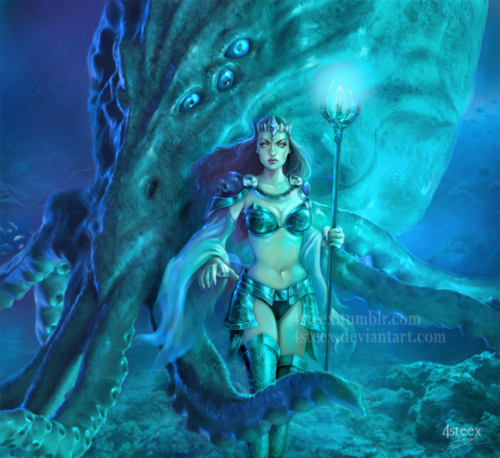#deepsea
Nothing says Mother’s Day like killing a salp and eating its insides to lay your eggs. #momlife
The barrel amphipod, Phronima sedentaria, uses its sharp claws to snag a salp, then rips out the soft tissues inside. But that salp is more than a meal—the amphipod carries around the carved-out carcass as its home. It even “remodels” its shelter by reshaping the barrel and secreting chemicals to toughen its tissues. Female barrel amphipods lay their eggs inside the salp and their hatchlings feast on the salp’s tissues.These tiny deep-sea treasures are about four centimeters (1.5 inches) long and are typically found from the surface to 600 meters (2,000 feet) deep.Dragonfish lurk in the dark depths
During a recent expedition aboard our research vessel Western Flyer, MBARI’s science team encountered a beautifully bronze deep-sea dragon. Meet the highfin dragonfish, Bathophilus flemingi.

MBARI researchers have observed a few different dragonfishes in the depths of Monterey Bay, but this one is the rarest we’ve encountered. We’ve only seen this particular species four times in more than three decades of deep-sea research and more than 27,600 hours of video! We spotted this individual just outside of Monterey Bay at about 300 meters (980 feet).

Bathophilus flemingi can be up to 16.5 centimeters (6.5 inches) long. Its fins have long, thin rays. Scientists suspect those wing-like filaments may sense vibrations in the water, alerting the fish when predators or prey are approaching. They likely provide stability and keep the fish from sinking while it lies in wait for food. These dragons don’t have scales—they have smooth, dark skin. Research by MBARI and our collaborators has revealed the pigments in the skin of some deep-sea dragonfishes are some of the blackest blacks found in nature, all the better to camouflage in the ocean’s midnight zone. Learn more on our Creature feature.
May the flapjack be with you today. #maythefourth
This fluffy flapjack was captured on camera snooping around one of our smart boulders or benthic event detectors (BEDs). MBARI engineers designed the rough-and-tumble BEDs to measure the near-seafloor conditions inside an underwater sediment gravity flow.
These boulder-like instruments rest on the seafloor and contain a package of motion-sensing tools. They were engineered to replicate the behavior of boulders in sediment gravity flows while collecting information about their own motion. These rugged devices can collect data within the densest part of a sediment gravity flow, where most of the mass is being carried. Buried BEDs have an acoustic homing beacon so they can be recovered by one of MBARI’s remotely operated vehicles or an autonomous vehicle, such as a Wave Glider, which can wirelessly download the data.
A shimmery moment of zen ✨
The dazzling deep-sea dweller Beroe forskalii is a fierce predator. Comb jellies, or ctenophores, are gelatinous animals that swim by waving tiny hair-like projections called “ctenes.” Beroe also has tiny hairs along its wide mouth that act like teeth and help it grab onto its prey. When it bumps into another comb jelly, it holds on using these “teeth,” opens its mouth wide, and tries to swallow its prey whole. Work, work, work, work, work
In the deep sea, our remotely operated vehicle (ROV) pilots have to use large robotic manipulator arms to recover delicate organisms like these carnivorous sponges, Cladorhiza evae.
Sitting in the ROV control room (some 2,400 meters or 7,870 feet above the vehicle), there are two ROV pilots, one flying the ROV and the copilot in charge of managing the tether and operating the vehicle’s manipulator arms. The copilot uses devices called masters to precisely control the movements of the arm. These masters are small representations of the manipulator arm on the ROV, and proportionally control each of the corresponding joints. The manipulator arms on both MBARI ROVs have collected all sorts of unique deep-sea organisms and objects—from glass sponges, clams, benthic ctenophores, and other organisms to volcanic ash, pillow lava, and different sediment samples—for our scientists to study.
These arms are incredibly powerful tools for learning more about the habitats and organisms that make up the deep sea!
ACTUAL FOOTAGE of us going into weekend mode.
Feather stars are echinoderms like the more familiar members of that group—sea stars, sea cucumbers, and sea urchins. Also known as crinoids, these graceful invertebrates can be found at depths ranging from shallow waters to deep areas on the seafloor from the Aleutian Islands off Alaska to Baja California, Mexico. Unlike their sea lily relatives, feather stars can swim away at the slightest disturbance.New species alert!
Atolla is one of the most common residents of the ocean’s midnight zone. This deep-sea crown jelly is found worldwide and can be abundant in deep water. Its bell has a signature scarlet color and bears one tentacle much longer than the rest. When MBARI researchers spotted a jelly that looked likeAtolla, but lacked the telltale trailing tentacle, their curiosity was piqued.

MBARI researchers have published the scientific description of a large new species of Atolla. They’ve named their discovery Atolla reynoldsi in honor of Jeff Reynolds, the first volunteer @montereybayaquarium, MBARI’s education and conservation partner. Learn more about the new species on our website.
High tech “smart boulders” give us a closer look at an underwater landslide.
The sediment that pours out of coastal rivers accumulates at the head of Monterey Canyon. Periodically, it collapses and forms a sediment gravity flow that surges through the submarine canyon like an underwater landslide.
Because these flows move quickly and powerfully along the seafloor, they are challenging for scientists to study. Motion-sensing “smart boulders” developed by MBARI engineers have provided the first detailed look inside sediment gravity flows.
MBARI researchers and our collaborators have learned that sediment gravity flows don’t just move along on top of the seafloor. These powerful landslides actually mobilize the top three meters (10 feet) of the seafloor, a finding with major implications for underwater infrastructure like cables carrying data and power to coastal communities. Learn more on our website.
It’s a jelly. It’s an egg case. It’s a … worm?
The balloon worm (Poeobius meseres) hardly looks like a worm at all. It lives in the midwater—the vast expanse of open water deep below the surface and far above the seafloor. Most marine polychaete worms—the more elaborate relatives of earthworms and leeches—have a clearly segmented body. Their bodies are divided into many nearly identical, repeated parts. Typically, each of those repeated parts is studded with several stiff bristles. Poeobius, however, has a bag-like body filled with fluid that, together with its thick gelatinous coat, provides buoyancy to help it stay up in the water column effortlessly. 
Poeobius is a common and very abundant resident of the midwater of Monterey Bay. It drifts through the water, collecting and eating bits of sinking organic matter in a mucous net. This little worm is actually an important part of cycling nutrients like carbon from the ocean’s surface to its depths. Learn more about these wondrous worms on our website.
Monday moment of zen with the relaxing rhythm of our favorite gelatinous zooplankton. 〰️
Sit back and relax with these soothing jellies. From tiny, delicate drifters, to giant deep-sea denizens, jellies come in a variety of beautiful and mesmerizing forms. There are many different kinds of gelatinous animals in the deep, but here we are featuring the umbrella-shaped animals that swim by pulsing a bell and usually have tentacles trailing behind their mellow flowing movement. Most people underestimate the true diversity of this dazzling group of animals. Taxonomically, they are far more varied than a handful of the most common examples used to represent “jellyfish.”
Swimming through snow.
When MBARI’s remotely operated vehicles (ROVs) dive into the deep sea, we descend through flurries of tiny particles that look like snow. We call this “marine snow”—a mixture of dead plankton, waste, mucus, and other organic material slowing sinking from the ocean’s surface.
In 2021, MBARI welcomed biological oceanographer Colleen Durkin to MBARI’s science team. Durkin’s research takes a closer look at marine snow to reveal the ecology of carbon export from the surface ocean into the deep sea. Her lab seeks to fill in the gaps in our understanding of the ocean’s carbon cycle by taking a closer look at marine snow. Read more about her research in this year’s Annual Report.
The latest edition of “if we don’t move Monday can’t see us."
Green bomber worms (Swima spp.) have specialized organs that explode with a burst of green bioluminescence. This impressive display is likely used to startle predators while the animal makes a speedy getaway. They live just above the seafloor and are vigorous swimmers, able to maneuver both backward and forwards.Each worm carries up to eight “bombs.” If they lose one, they can grow it back. The “bombs” may have been gills that evolutionarily transformed over time. Although these worms lack eyes, they have developed a novel bioluminescent defense mechanism. MBARI research has shown that approximately three-quarters of the animals living in the dark ocean depths are capable of producing bioluminescence.Deep diving submersible exploring the dark depths of the ocean. #sketchbook #sketch #sketchoftheday #drawingoftheday #artist #artoftheday #artofinstagram #watercolor #pendrawing #art #deepsea #oceanexplorer #submersible #submarine #scifi #conceptart #conceptdesign #vehicledesign #instaart #instaartist
Post link
Been watching Blue Planet documentary and got inspired to do a deep sea submarine sketch. Also a homage to Jules Verne! #sketch #sketchoftheday #artwork #sketchbook #inkdrawing #deepsea #submarine #nautical #nautilus #scifi #scifiart #ship #drawingoftheday #drawing #julesverne #artist #artoftheday #instaartist #instaart #submersible
Post link



